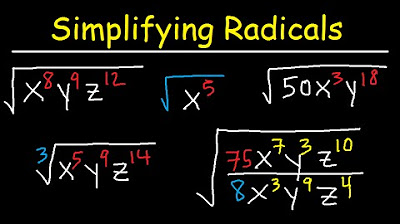Multiplying Rational Expressions
Summary
TLDRThis educational video script offers a comprehensive guide on multiplying and simplifying rational expressions. It begins with a step-by-step demonstration of factoring and canceling terms in a given expression, highlighting the importance of identifying and extracting the greatest common factor (GCF). The script then moves on to factoring trinomials and using the difference of squares technique. It further illustrates how to handle expressions with leading coefficients other than one by multiplying them with the constant term. The video also addresses the identification of excluded values, crucial for avoiding division by zero. Finally, it demonstrates the process of factoring a difference of perfect cubes and concludes with a complete factorization and simplification of a complex rational expression.
Takeaways
- 📘 Multiplying rational expressions involves converting them into fractions and then multiplying the numerators and denominators accordingly.
- 🔍 Factoring expressions completely is crucial before multiplying to simplify the process and identify common factors for cancellation.
- 🧩 The greatest common factor (GCF) is used to simplify expressions by dividing out common factors from the numerator and denominator.
- ✂️ Cancelling common factors between the numerator and denominator is a key step in simplifying rational expressions.
- 🔢 Factoring trinomials involves finding two numbers that multiply to the constant term and add up to the middle coefficient.
- 🔄 The difference of squares technique is used to factor expressions of the form a^2 - b^2 into (a + b)(a - b).
- 📏 Factoring by grouping is a method used for expressions where the coefficients follow a pattern that allows for common factors to be extracted.
- 📉 Identifying excluded values, or points of discontinuity, is important as they represent values that make the denominator zero and are not valid for the expression.
- 🔑 The difference of cubes formula a^3 - b^3 = (a - b)(a^2 + ab + b^2) is used to factor expressions involving the difference of two cubes.
- ✅ Simplifying rational expressions results in a final expression that is easier to work with and understand.
Q & A
What is the first step when multiplying rational expressions?
-The first step is to ensure that the expressions are in fractional form and then to factor them completely.
How do you simplify the expression 7x + 14 divided by x^2 - 8?
-First, factor out the greatest common factor (GCF) of 7 from the numerator to get 7(x + 2). Then factor the denominator using the difference of squares to get (x + 2)(x - 2). After canceling out common factors, the simplified form is x + 2.
What technique is used to factor x^2 - 4?
-The difference of perfect squares technique is used, which results in (x + 2)(x - 2).
What are the excluded values when simplifying rational expressions?
-Excluded values are the values of the variable that make any denominator zero. These values are identified by setting each factor in the denominator equal to zero.
How do you factor the trinomial 10x^3 - 70x^2 + 120x?
-First, take out the GCF of 10x, resulting in x^2 - 7x + 12. Then, factor by grouping or by finding two numbers that multiply to 24 (2*12) and add to -7 (-8 + 3), which are -8 and 3. The factored form is (x - 3)(x + 4).
What is the process for factoring a difference of perfect cubes?
-The formula for factoring a difference of perfect cubes is a^3 - b^3 = (a - b)(a^2 + ab + b^2). Identify 'a' and 'b' such that a^3 is the first term and b^3 is the last term of the cube difference.
How do you simplify the expression 5x^2 - 15x divided by 2x^2 + 11x + 12?
-First, take out the GCF of 5x from the numerator. Then, factor the quadratic in the denominator by finding two numbers that multiply to 24 and add to 11, which are 8 and 3. The simplified form is x - 3 over 2(x + 4).
What is the final simplified form of the expression 7x + 14 divided by x^2 - 8 multiplied by x^2 + 3x - 10?
-After factoring and canceling, the final simplified form is 7(x + 5)/2.
How do you identify the points of discontinuity in a rational expression?
-Points of discontinuity are identified by finding the values of the variable that make any factor in the denominator equal to zero, as these values would make the expression undefined.
What is the final simplified form of the expression 3x^3 - 24 divided by 2x^2 - 14x + 20 times 4x^3 - 20x^2 + 3x - 15 divided by x^2 + 6x + 12?
-After factoring and canceling, the final simplified form is 4x^2 + 3/2.
Outlines

Cette section est réservée aux utilisateurs payants. Améliorez votre compte pour accéder à cette section.
Améliorer maintenantMindmap

Cette section est réservée aux utilisateurs payants. Améliorez votre compte pour accéder à cette section.
Améliorer maintenantKeywords

Cette section est réservée aux utilisateurs payants. Améliorez votre compte pour accéder à cette section.
Améliorer maintenantHighlights

Cette section est réservée aux utilisateurs payants. Améliorez votre compte pour accéder à cette section.
Améliorer maintenantTranscripts

Cette section est réservée aux utilisateurs payants. Améliorez votre compte pour accéder à cette section.
Améliorer maintenantVoir Plus de Vidéos Connexes

MULTIPLICATION AND DIVISION OF RATIONAL ALGEBRAIC EXPRESSIONS || GRADE 8 MATHEMATICS Q1

Solving Equations Transformable into Quadratic Equations

Simplifying Radicals With Variables, Exponents, Fractions, Cube Roots - Algebra

Solving Rational Equations | General Mathematics

8TH EDITION | BOOK 2 | EXERCISE 3A | QUESTION # 1, 2, 3

Adding and Subtracting Rational Expressions With The Same Denominators
5.0 / 5 (0 votes)
